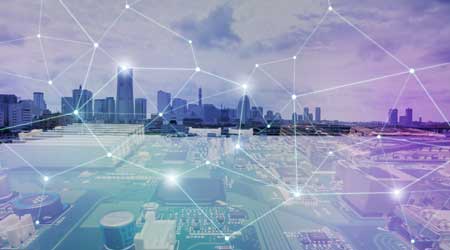How Distributed Energy Resources (DER) Augment Smart Grid, Energy Savings
From photovoltaics (PVs) to electric vehicles (EVs), many distributed energy resources can play vital roles in a building's grid-readiness and ability to take advantage of smart grid.
Distributed energy resources (DER) are electricity-producing resources, energy storage, or controllable loads. The Smart Grid Application Guide is focusing on DER that are connected behind a building's electric meter. DER are an important group of smart grid technologies. The connection between DER and the local electric grid is often called interconnection, and each facility must meet various requirements to qualify for interconnection.
Photovoltaics systems (PV) use the photovoltaic effect to convert sunlight into electricity. An inverter then converts and conditions the direct current created by the PV array into alternating current. The primary benefits of a PV system are reduced utility bills from the decrease in grid-provided electricity. When electrical storage and islanding in a microgrid arrangement are added, PV systems can provide increased reliability and resilience to a facility. Facility managers can refer to the DOE Better Building Alliance's On-Site Commercial Solar PV Decision Guide for PV design and operational considerations.
Battery storage costs are decreasing rapidly and can now be economically justified in some facilities as a combination of backup power source and grid service provider (where rates and incentives are favorable). Facility managers may want to "value stack" to take advantage of the multiple benefits batteries can provide. Utilities may have multiple incentive programs (for frequency regulation, capacity bidding, demand charge reductions, and Time-of-Use rates, etc.). Battery storage can be enrolled in multiple of these programs, possibly at different times, providing more incentives to the building owner and making it easier to justify the investment in batteries.
Cool thermal storage makes use of the fact that air conditioning and refrigeration are often operating when the grid is most in need of relief. Cool storage can be discharged during these times, allowing compressors to remain off. There are a few forms of cool thermal storage: ice storage, chilled water storage, phase change material thermal storage, and refrigeration thermal storage. The first two types are well-established, and an ASHRAE Design Guide with complete best practice guidance exists. Future versions of this guidance may include new smart grid benefits like Automated Demand Response (ADR) and net metering of solar. There is less guidance available for the other two forms; manufacturer specifications will need to be referred to when these storages are considered.
Smart inverters can convert electrical power from D.C. to A.C. – needed for PV and battery applications – while synchronizing with the grid's voltage, frequency, and phase – a modulation service to the grid. They are a critical piece in ensuring DERs operate effectively and actively, stabilizing the grid's power quality. They also have communication capabilities that allow utilities to both see inverter status and potentially control their behavior. Advanced inverters have seen limited deployment to date with pilot deployments in areas with significant PV penetration.
Electric Vehicles (EV) use electricity as their primary fuel, storing electrical energy in a battery and using an electric motor to convert it into motion. Because EVs plug into recharge, they may be considered an extension of a building's electrical system. Electric Vehicle Supply Equipment (EVSE) is the equipment that EVs use to recharge, and may include conductors, plugs, fittings, and outlets, among other components. EVSE falls into three categories: Level 1, Level 2, and DC Fast Charging. Each level will charge at different rates and at different voltages. If facility managers consider installing EVSEs in their building’s parking lot, the first step is to estimate the number of charging stations. Designers should then determine whether existing infrastructure can serve additional EVSE. New circuits may need to be added, and electrical equipment upgraded accordingly.
Related Topics:














